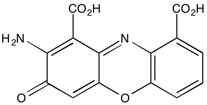Cinnabarinic acid | Endogenous AhR ligand
NMR (Conforms)

Available Options
| Size: | Price | Quantity | |
|---|---|---|---|
| 5 mg | $50.00 | ||
| 25 mg | $198.00 |
Cinnabarinic acid (606-59-7) is a novel endogenous tryptophan metabolite which acts as an aryl hydrocarbon receptor (AHR) agonist.1 It drives IL-22 production by stimulating the differentiation of human and mouse T cells producing IL-22.1 Induces apoptosis in thymocytes.2 Activates type 4 metabotropic glutamate receptors.3 Cinnabarinic acid counteracts excitotoxic neuronal cell death induced by NMDA in mixed cultures of cortical cells. Displays neuroprotective activity.3
References/Citations:
1) Lowe et al. (2014), Identification of cinnabarinic acid as a novel endogenous aryl hydrocarbon receptor ligand that drives IL-22 production; PLoS One, 9(2) e87877
2) Hiramatsu et al. (2008), Cinnabarinic acid generated from 3-hydroxyanthranilic acid strongly induces apoptosis in thymocytes through the generation of reactive oxygen species and the induction of caspase; J. Cell. Biochem., 103 42
3) Fazio et al. (2012), Cinnabarinic acid, an endogenous metabolite of the kynurenine pathway, activates type 4 metabotropic glutamate receptors; Mol. Pharmacol., 81 643
NMR (Conforms)
Safety Data Sheet:
Product Data Sheet:
Materials provided by Focus Biomolecules are for laboratory research use only and are not intended for human or veterinary applications. Please note that we do not sell to individuals and that all orders placed by non-research organizations will incur a $20 restocking/refund fee
Cinnabarinic acid (606-59-7) is a novel endogenous tryptophan metabolite which acts as an aryl hydrocarbon receptor (AHR) agonist.1 It drives IL-22 production by stimulating the differentiation of human and mouse T cells producing IL-22.1 Induces apoptosis in thymocytes.2 Activates type 4 metabotropic glutamate receptors.3 Cinnabarinic acid counteracts excitotoxic neuronal cell death induced by NMDA in mixed cultures of cortical cells. Displays neuroprotective activity.3
References/Citations:
1) Lowe et al. (2014), Identification of cinnabarinic acid as a novel endogenous aryl hydrocarbon receptor ligand that drives IL-22 production; PLoS One, 9(2) e87877
2) Hiramatsu et al. (2008), Cinnabarinic acid generated from 3-hydroxyanthranilic acid strongly induces apoptosis in thymocytes through the generation of reactive oxygen species and the induction of caspase; J. Cell. Biochem., 103 42
3) Fazio et al. (2012), Cinnabarinic acid, an endogenous metabolite of the kynurenine pathway, activates type 4 metabotropic glutamate receptors; Mol. Pharmacol., 81 643
Related Aryl Hydrocarbon Receptor Products
Download
Calculate the molar concentration, mass or volume in a solution.
Concentration × Volume × Molecular Weight = Mass
Focus Biomolecules • Plymouth Meeting, PA USA • 1-855-FOCUS21
Focus Biomolecules
Plymouth Meeting, PA USA
1-855-FOCUS21
Website Created by Advanta Advertising LLC.

